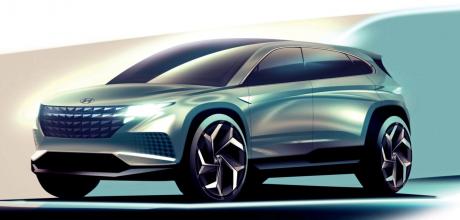2023 Hyundai Nexo New FCEV to start ‘mainstream’ push
Hyundai forges ahead with hydrogen powertrain tech The 2023 Nexo to spawn a new family of Hyundai fuel cell electric vehicles.
Hyundai intends its second-generation Nexo to be a much more mainstream proposition than today’s car as it embarks on a landmark drive to “popularise” hydrogen as an alternative fuel by 2040. Due in 2023, the SUV will use Hyundai’s new 100kW hydrogen fuel cell stack – the third evolution of the Korean company’s hardware, the original having appeared in the pioneering ix35 Fuel Cell from 2013.
Some 30% smaller than the current stack to facilitate use in a wider variety of market segments, the new stack is designed to offer significantly enhanced durability over its predecessors. Hyundai estimates the current Nexo’s powertrain is capable of 5000 hours or 100,000 miles of use; the new one is projected to boost those figures by between 50% and 100%. The advances made in this area are all part of Hyundai’s dual-pronged approach to electrification, by which fuel cell electric vehicles (FCEVs) will become as important as its Ioniq-badged family of battery-electric vehicles (BEVs).
“We’re committed to both battery and fuel cell technologies,” confirmed a Hyundai spokesman at the Munich motor show. The key attributes behind hydrogen’s appeal include its capacity for long driving ranges and short refuelling times. Crucial to the large-scale roll-out of hydrogen will be Hyundai’s aim to achieve cost parity between BEVs and FCEVs by 2030, suggesting the Nexo could become a closely priced alternative to the similarly sized Ioniq 5 BEV in its next-generation form. Beyond the Nexo, Hyundai will use its technology for a pair of new stand-alone FCEVs: an MPV in 2023 and a full-size SUV in 2025. Volume sales of vehicles such as these will play a crucial role in the firm’s newly detailed plan to electrify its European fleet by 2035 and all global models by 2040.
Hyundai showcased the potential of hydrogen at the Munich motor show with a new sports car, referred to at the concept stage as the Vision FK. Packing more than 671bhp, it can sprint from 0-62mph in less than 4.0sec and achieve a range of more than 373 miles.
Uniquely, the Vision FK pairs its hydrogen fuel cell stack with a Rimac-developed battery-electric powertrain to drive the rear wheels. It would be the first car to use both systems, assuming it reaches production unchanged.
Hyundai has previously suggested that future models from its N performance division will adopt hydrogen powertrain solutions, and the Vision FK concept is the first physical sign that they will indeed “use a combination of both” battery and hydrogen power sources, as suggested by chief marketing officer Thomas Schemera earlier this year. Hyundai is developing the Vision FK as a “rolling lab”, similar to the previous RM19 mid-engined racer concept.
Rimac, in which Hyundai holds a substantial stake, was chosen as an EV technology supplier because Hyundai’s own E-GMP platform couldn’t facilitate the Vision FK’s “very challenging” packaging.
Rimac has “specialised batteries” available for such an application, most likely related to those used by the Croatian company’s Nevera hypercar.
Away from the passenger car sector, Hyundai has detailed a separate, 200kW version of the new fuel cell stack destined exclusively for its commercial vehicles, all of which will be offered with an FCEV powertrain by 2028. This goal, it says, will make Hyundai the “first global auto maker to realise such ambitions for commercial vehicle transportation and will further help facilitate the transition to sustainable mobility”.
Hyundai is already set to be first to market with a hydrogen-powered HGV (the Xcient) in 2023, and it’s now capitalising on its first-mover position by unveiling new concepts that could cement hydrogen as the primary fuel used by the commercial vehicle sector. The Trailer Drone concept, for example, is a hydrogen-fuelled shipping container transportation system that can operate fully autonomously for distances of more than 620 miles. It’s not a mere evolution of the hydrogen technology used in Hyundai’s passenger cars but rather the result of extensive engineering work to “redefine how a container manoeuvres”.
In essence, the system centres on a hydrogen-fuelled bogie that sits beneath the container – much like on a rail-freight wagon – to move it autonomously through shipyards and “tight urban environments”.
The concept is capable of four-wheel steering, can move side to side and can be mated with other units to form a kind of train. Hyundai predicts that by 2040, hydrogen will be used not just in mobility solutions but also as a power source in various other industries and sectors. It has even suggested that its hydrogen power units could be used by “large IT companies” and – in their largest configuration, in which they can produce up to 1MW of power – container ships.
The key attributes behind hydrogen’s appeal include its capacity for long ranges and short refuelling times
Trailer Drone could revolutionise goods transportation. New Nexo will be lighter, more frugal and longer lasting. Vision FK sports car concept uses both FCEV and BEV technology


